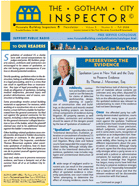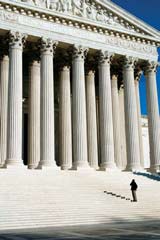- Publications:
- Newsletter:
- How-To Tutorials:
- Consumer Guides:
- Related:

Image by Robert Ubell
Publishers:
Accurate Building Inspectors ©
Division of Ubell Enterprises, Inc.
1860 Bath Avenue
Brooklyn, NY 11214-4616
voice – 718.265.8191
toll free voice – 800.640.8285
fax – 718.449.7190
Lawrence J. Ubell *
- President
Alvin Ubell **
- Founder, Vice President
Matthew Barnett *
- Senior Inspector
Estelle R. Ubell
- Sec. Treasurer
Jennifer S. Bleyer
- Editor-in-Chief
Contributors:
Thomas J. Moverman, Esq.
of Lipsig, Shapey, Manus & Moverman, PC
Adam Leitman Bailey, Esq.
Hon. Jules L. Sprodek, (RET)
Robert H. Wolff, Esq. of Rosenberg,
Minc, Falkoff
& Wolff, LLP
Ari Saltz, of GFI Mortgage Bankers, Inc.
Stanley Turkel, MHS, ISHC
Bertrum Herman, Esq.
Howard Kurtzberg, Esq.
Mitchell D. Kessler, Esq.
Sebastian M. D'Alessandro, RA
Terrence E. O'Neal, RA, AIA
David A. Kaminsky, Esq.
John Gallagher, RA AIA
* Licensed in: New York - New Jersey
** Licensed in: NJ
Contribute:
If there is a subject that you would like to see discussed or an article that you would like to contribute to be featured
in The Gotham City Inspector©, please forward your comments to:
Letters to the Editor
Media Notice: The publishers, grant reprint permission of all articles in the Gotham City Inspector© Newsletter, provided that appropriate written recognition is given to the authors and “The Gotham City Inspector©”. For online reprints, please also include an HTML link to The Gotham City Inspector© : www.accuratebuilding.com

The Gotham City Inspector©
Newsletter: Fall 2008, Vol.5, No.2

![]() Gotham City Inspector Newsletter
Gotham City Inspector Newsletter
Fall Headlines:
Living In New York
Preserving the Evidence
Spoliation laws in New York and the Duty to Preserve Evidence
-by Thomas J. Moverman, Esq., www.lipsig.com

Architects, contractors and builders can be sued or can file lawsuits for claims of defective workmanship, design, planning, or supervision of construction sites and buildings, so documents and records created during building projects can become critical components of evidence during litigation. All property owners as well as builders, contractors and architects should be aware of the dangers posed by the law of “spoliation of evidence.”
“Spoliation” typically refers to the “intentional destruction, mutilation, alteration or concealment of evidence,”(1) and it has become a growing issue in civil litigation. Many state and federal courts have expanded the scope of spoliation liability. Although initially identified as the intentional destruction of evidence, spoliation now includes negligent and unintentional destruction of evidence.
A wide range of negligent and/or innocent acts can result in the unwanted spoliation of evidence. And while the effect of spoliated evidence is inherently speculative, one court noted that “when attempting to determine the effect of missing evidence, courts face the treacherous task of divining the import of materials whose contents are unknown and, very often, disputed.”(2) For this reason, the burden most often falls on the off ended party to prove that the spoliated evidence was relevant to substantiating its claim if the evidence had not been destroyed.
Once the off ended party has sufficiently demonstrated spoliation, courts respond with many types of punishment against the spoliator. Traditional judicial actions have included monetary sanctions, dismissal, issue preclusion, default judgment, criminal penalties, and in some state courts, recognition of spoliation as an independent tort. However, the use of such judicial actions varies widely, often having to do with diff erent requirements about the preservation of evidence. Although nearly all courts agree that the duty automatically emerges when a party serves or is served with a judicial or administrative complaint, for example, when a party has actual knowledge that litigation has begun, many courts have held that the duty to preserve evidence emerges as soon as it is “reasonably foreseeable” that a lawsuit will ensue and that the relevant evidence will be discoverable in connection with that lawsuit.

For example, according to a federal court in New York, a jury may find the destruction of records, regardless of whether any lawsuit or congressional investigation has begun, to be an act of spoliation in anticipation of litigation. (3) Therefore, although the mere possibility of future litigation by itself isn't enough to create a duty to preserve evidence, an “obligation to preserve evidence [can arise] prior to the filing of a complaint where a party is on notice that litigation is likely to be commenced.” (4)
This legal standard raises the stakes for all property owners as well as builders, contractors and architects involved in or likely to be involved in litigation. It has always been the legal rule that a party that misplaces or destroys relevant evidence faces the possibility that a court will instruct a jury to “draw the strongest possible inference” against the party that cannot produce its evidence in court.

Moreover, today's increasing use of digital records and computer data has raised a new set of questions and concerns around the duty to preserve digital evidence. Consequently, those in possession of evidence, either digital or analog, that might be relevant to litigation must be extremely careful to preserve any such evidence at the outset or else risk potential spoliation liability.
Unlike other states like California, New York courts do not take the spoliator's motive into account when determining what punishment to apply. (5) By disregarding whether the spoliation was intentional or non-intentional, New York's approach has blurred the common-law distinction between active destruction and the simple failure to preserve evidence. Instead, the New York approach is to ask only whether a particular punishment is fair to the injured party and not disproportionately prejudicial to the spoliating party. As a result, the court can apply harsh sanctions with relative impunity, even for inadvertent, negligent spoliations of evidence.
For example, in Kirkland v. New York City Housing Authority, the court held that the housing authority's destruction of a stove required dismissal of its complaint against the stove's installer as a spoliation sanction, regardless of whether destruction was intentional or negligent. (6) For the most part, however, documents and other potentially relevant evidence is only subject to preservation when litigation is pending or anticipated.
Until last year, New York courts had not ruled whether spoliation, either intentional or negligent, should be recognized as an independent tort. However, in one 2007 case, the state's highest court explicitly rejected “spoliation of evidence” as an independent tort claim. The court found that “New York courts have been reluctant to embrace claims that rely on hypothetical theories or speculative assumptions about the nature of the harm incurred or the extent of plaintiff's damages.” (7) Likewise, the court acknowledged that “in New York, while the desire to provide an avenue to redress wrongs is certainly an important consideration underlying our tort jurisprudence, the recognition that there has been an interference with an interest worthy of protection has been the beginning, not the end, of our analysis.” In analyzing typical proximate cause and actual damage standards, the court concluded that “based on a review of cases across the nation, it appears that destruction of evidence by an entity without ties to the underlying litigation is not a frequent occurrence.” (8)

There are some preventative steps that can help lessen the risks and challenges associated with the frequently negligent spoliation of evidence.
MAINTAIN A FORMAL, ACCURATE PROJECT SCHEDULE Owners, builders and contractors can benefit by maintaining both a formalized and accurate project schedule, keeping timely and organized records of project progress and activities as they occur. Along these lines, another preventative measure includes having all of the project staff keep individual records of daily events throughout the building process. This might mean creating a “uniform” set of guidelines and procedures that articulate the necessary process for preserving documents and identifying the situations when a document may be safely discarded. For architects, it is prudent to keep records of original or “as built” drawings.
KEEP RECORDS OF ALL PROJECT CONTRACTS AND DOCUMENTS For both architects and builders, it is important to keep well-established and accurate records of any and all contracts related to a project. Similarly, all correspondence, including written notes of meetings and discussions, should be kept on file, as they might later be helpful in proving good faith and eff orts aimed at reasonable steps to preserve evidence. Courts tend to look more favorably on parties who have made an explicit effort to preserve records and document information. Keeping a physical copy of every record, document, correspondence or drawing on file can take up a considerable amount of space, presenting excessive cost burdens for even the largest businesses. For this reason, workers and companies of all sizes have gone digital when it comes to retaining large quantities of information. In 2002, it was estimated that more than 93 percent of all business documents were created in digital form, (9) and the number keeps growing. As such, special care and attention should especially be given to digital records due to the burgeoning burden of electronic discovery.

Some discoverable information can be in unanticipated locations such as telephones, PDAs, scanners, printers, jump drives, mobile phones and content from discontinued Web sites. Sometimes, information is invisible to the average user; such “invisible” information may (10) include documents that contain metadata recording details of users, their comments, and any changes they make. Therefore, after the duty to preserve certain electronic files and/or data arises in light of pending litigation, it is important to be very cautious so that data is not unintentionally lost or subject to change. Keep in mind: merely accessing an electronic file has the potential to destroy and override discoverable metadata and digital information. If in doubt, the best advice for avoiding the risks of electronic spoliation is to consult a lawyer who has a well-founded understanding of electronic discovery and the specific issues it raises.
Perhaps the most important thing to remember when evaluating any document retention or destruction policy is whether a judge and/or jury will consider such policies as “reasonable” in the context of pending or ongoing litigation. As previously stated, “a party is not obligated to retain every document or tangible item that is in its possession, or subject to its control, after a complaint has been filed.” However, exercising preventative steps geared towards curbing the possibility of negligent spoliation cannot and should not be underestimated.
Mr. Moverman is a founding attorney of Lipsig, Shapey, Manus & Moverman, P.C. He specializes in products liability, including cases arising from defective machinery, tools, autos, occupant protection and injury from toxic substances, chemicals and medication in New York state and federal courts.
Visit: www.lipsig.com
- BLACK'S LAW DICTIONARY, 1437 (8th ed. 2004).
- Robert D. Peltz, The Necessity of Redefining Spoliation of Evidence Remedies in Florida, 29 FLA. ST. U. L.REV. 1289, 1337 (2002) (citing Arizona v. Youngblood, 488 U.S. 51, 57-58 (1988) (citations omitted)).
- Shamis v. Ambassador Factors Corp., 34 F. Supp. 2d 879, 888-89 (S.D.N.Y. 1999); Kronisch v. United States, 150 F.3d 112, 126-27 (2d Cir. 1998).
- Turner v. Hudson Transit Lines, Inc., 142 F.R.D. 68, 73 (S.D.N.Y. 1991) (The obligation to … is likely to be commenced.”); Shaffer v. RWP Group, Inc., 169 F.R.D. 19, 24
(E.D.N.Y. 1996) (Defendant destroyed documents after receiving complaint which alerted defendant that such documents were relevant and likely to be sought in discovery. Therefore, found that such destruction did constitute spoliation of evidence.)- West v. Goodyear Tire & Rubber Co., 167 F.3d 776 (2d Cir. 1999).
- Kirkland v. NYC Hous. Auth., 666 N.Y.S.2d 609 (App. Div. 1997). Also see Squitieri v. City of New York, 669 N.Y.S.2d 589, 590 (App. Div. 1998) (“Dismissal is warranted when discovery orders were not violated, and even when the evidence was destroyed prior to the action being filed … notwithstanding that the destruction was not malicious … or in bad faith.”).
- See e.g. Becker v. Schwartz, 46 NY2d. 401 (1978).
- See e.g. Byrnie v. Town of Cromwell, Bd. of Education, 243 F.3d 93, 107-08 (2 Cir. 2001).
- Wendy R. Liowitz, Digital Discovery Starts to Work, National Law Journal, Nov. 4, 2002).
- Wendy R. Liowitz, Digital Discovery Starts to Work, National Law Journal, Nov. 4, 2002).
- James W. Moore et al., Moore's Federal Practice § 37.120 (3d ed. 1999).
The author gratefully acknowledges the assistance of Melissa Solomon, summer intern, who is about to begin law school at the University of Pennsylvania.
To Our Readers
Spoliation of evidence! It's a clunky term with varied interpretations by judges and juries. All, builders, property owners, architects and contractors are encouraged to be aware of spoliation, or else risk facing grave consequences if you lose or discard potential evidence.
Strictly speaking, spoliation refers to the destruction, hiding or withholding of evidence in a legal proceeding, and it is a crime that can result in significant fines or incarceration. Any type of legal proceeding can include an allegation of spoliation, including medical malpractice, personal injury and product defectiveness, and of course, construction or building cases.
Some proceedings involve actual building materials or equipment. For instance, while working at a construction site as a subcontractor, a man fell from a ladder he had borrowed from the general contractor. He filed suit against the general contractor for his injuries, including a claim seeking damages for the general contractor's alleged destruction or loss of the ladder, which the plaintiff claimed was vital to his additional lawsuit against the ladder's manufacturer.
Other building-related spoliation cases simply involve destroyed or hidden documents, blueprints or contracts. In this special issue of Gotham City Inspector, contributor Thomas Moverman explains what constitutes spoliation of evidence, how it's been interpreted in New York State, and what you can do to protect yourself against grievous spoliation claims.
“Helpful ideas at your finger tips!”
If you would like to receive the The Gotham City Inspector© newsletter, please email
your request and include your name, business name, business telephone and address.
E-mail: [email protected]
Copyright Ubell Enterprises, Inc. 2007 ©
Accurate Building Inspectors provides home inspection services throughout New York, NYC, Bronx, Brooklyn, Harlem, Long Island, Queens, Staten Island & New Jersey (NJ)





